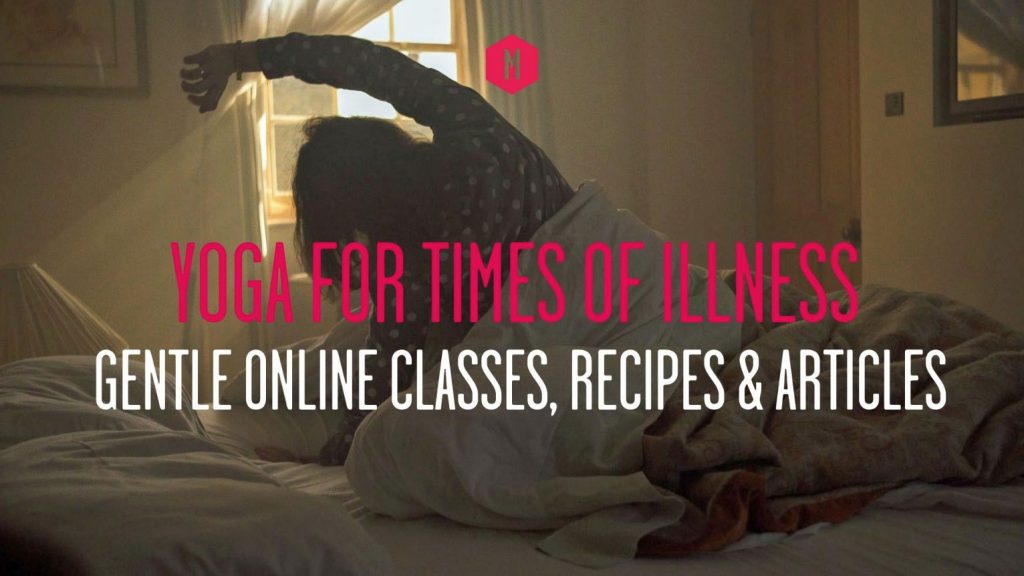
MFML teacher Lizzie Reumont suggests that periods of illness might just be the best time to practice yoga. Drawing on personal experience, Lizzie offers yoga tools to feel better
Yoga Tools to Feel Better
We’ve all felt unwell at some point, and know it’s no fun. What might not be so obvious though, is how being sick physically can have lasting effects on many areas of our lives; first and foremost, how it can impact our mental health, which can lead us to thinking that it interrupts things in our life that are important, like our yoga practice. I hope this article helps to clear up that misconception, and provide you with some yoga tools to help you through the ‘un’ to get you back to ‘well’.
I use the term ‘mental health’ broadly, for this can cover everything from our projected expectations of plans and the associated disappointment with not being able to follow through with them, to illness-related depression and anxiety. How does one cope with the urge to do more when the body is telling you to do less? How can we better manage the depression, anxiety and even the ultimate fear of dying that comes with being seriously unwell?
It might be helpful to know as you read, a little bit about the writer. I’m a 48 year old woman who has been living with a chronic, auto-immune disease since I was three years old. Seven years ago I had a liver transplant, and since that time, I have had related spinal surgery and monthly trips to the hospital for infusions and continual changes in medication and care. I live with elevated levels of uncertainty on a daily basis about not if, but when I will be severely unwell again. In a nutshell, everything I am sharing with you here is based on personal experience.
LESSON ONE: Adaptability and Balance over Strength and Power
I spent a good part of my younger adult life in conflict. Even when I felt unwell, I tended to be of the mindset to ‘power through’, to put on a brave face and get through those days of illness, only to collapse behind closed doors later on. People who knew me would comment on how powerful I was, which bolstered up my ego, but left me with a tinge of inner turmoil because I didn’t feel powerful; I felt disingenuous to myself for not listening to my needs, for not practicing what I preached as a yoga teacher. In retrospect, rather than strength and power, I should have been practicing adaptability and self care.
To be clear, most of the time, self care does not mean doing nothing. Sure, when you are in bed with a fever and cough, taking it easy with a cup of tea and hot water bottle until the ‘eye of the storm’ has passed makes a lot of sense.
On either end of an illness though, is a beautiful time of discomfort and disruption, that surely does not feel so beautiful when we are in it! By beautiful, I mean a time to investigate being in the present moment of not being stuck in the ‘status quo’ pattern of daily life: a ‘beautiful’ moment of being with what is means there is space to ‘try on’ on a new dialogue with your body, whether that is inviting more subtle movements, a restorative or yin yoga class, or simply lying on your back and seeing how your body chooses to move, if at all.
Adaptability affords you the ability to be present in the given moment and navigate your needs from that vantage point – not based on what you did yesterday or what you will do tomorrow. Feeling unwell is a time to be explorative and adaptable, to deepen the awareness of vulnerability; to look for balance even in the state of flux.
LESSON TWO: Learn the meaning of Support
Today’s world celebrates ‘goal crushing’. There is endless talk of achieving results, when rarely do we hear about the journey of getting ‘there’. Practicing yoga flips these contemporary ideas of success on its side. Yoga is all about the journey. The journey of illness means that instead of swimming in the stream of pushing yourself to get ‘there’, you wade in the waters of what is…and treading water with ‘what is’ as someone who is in the midst of illness means that you need support!
Support comes in many forms. I will mention a few here, but the most important support is the support you give yourself from your inner champion who will encourage you to lay low, who will give you permission to do less; who will help you listen to your true needs instead of what the ego may be telling you about what you think you need. This requires learning to stay with the invitation to be present with your whole system a little longer. Support can also mean having a friend or family member to guide and encourage you to follow through and help you take care of yourself. Support can also come in the form of a deep inner listening. Here is one example of what that could look like as a ‘tuning in’ exercise.
Step 1. Seated or lying meditation.
Turn off the phone, lower the lights. Place your hands on your chest or belly and become still. Say to yourself, ‘Self, what do I need right now to feel whole, to feel nourished?’ Your thinking mind may respond first, which is why staying with it beyond all of the impulsive voices that feel they need to be heard is important. These initial voices may come across as bossy, impatient and self-sabotaging. After a period of time though, a more authentic voice will inevitably come through. How will you know, you might wonder, which voice is the one that is true to your inner self? That voice will feel soft, full of compassion and be without anger, frustration or any negativity. It will feel like coming home. You will know.
Step 2. Use your breathing.
Rather than doing any one exercise, simply listen and feel yourself breathing. Invite it into your body, not strained or forced. Imagine it is nourishing your cells, your tissues, your organs. Allow your breathing to be normal, encourage it to be full; complete. Breathing itself can be a support as well also a resource to come back to, to reconnect the present moment, to the here and now.
Step 3. When you are ready to invite movement into the body, consider a practice with plenty of props.
Bring the floor up to you by using a chair or blocks. Place a bolster along the spine and lie down on it to invite the chest to open. If that is too dramatic for your body, roll up a blanket and try that. Use a bolster on top of your thighs, or underneath, when lying down to rest. The point is, when you are ill or recovering from illness, take time to feel what is going on both inside, and in your outer physicality, and give your body any scaffolding it needs to feel supported.
If you are not sure what your body needs, take a little time to meet yourself where you are from a place of curiosity and love, like that you would give a small child learning to walk, is the first step. Why curiosity? It was Abraham Lincoln who said “I don’t like that man, I must get to know him better”. When we consider that most of us look at illness as something we don’t like, it sets up a relationship that is exclusive; that denies us of feelings and emotions associated with feeling unwell. We don’t want to look at the illness and it’s associated sensations, so we shun it away. I’m suggesting that rather than push it away, invite it in; get to know it and treat it like a small child that needs to be seen, heard and felt.
LESSON THREE: Put the practice into perspective
Anything can be a yoga practice: washing dishes, giving yourself a bath — feeding the birds. Yoga is not about the what, it is about the how and why. If you are feeling crappy and your mind is getting the best of you and you are pressure on yourself to go about your normal day and physical regime when you are not feeling ‘normal’, start by asking yourself ‘why’. What is behind the expectation? Is your mandate to assuage your ego, or to meet yourself where you are? Yoga is about meeting yourself where you are. Yoga, remember, means to yoke: to integrate the self that lives in the world in daily life, with the self that dwells within – call it the soul, your basic goodness or the essential part of you. This can be done at anytime, anywhere, by encouraging the mind and to stay in the present tense.
And how about the how? How are you feeding the birds, for example. Are you moving quickly and clumsily, stressed and out of obligation, or are you taking time to clean the feeders, to choose the best food for the birds who come to your house, chanting or humming as you tend to these wonderful, soulful earth cousins? The point is, whatever practice you are embarking on, question the why, and notice the how. The ‘how’ in yoga is by offering up your practice- whatever your are cultivating – to the highest intention that you can imagine, for example, equality, peace and happiness for all beings. So, if you make yourself a bath, do it with the care you would take for your inner queen or king; create food with the love and tenderness you would feed a saint; offer your birds a meal for holy, winged beings!
LESSON FOUR: Practice knowledge
It is not always easy to read a book when you are unwell, let alone read yoga philosophy! It is the philosophy of yoga though, that might just hold the key to getting you through the times when we suffer most. That is why continuing to learn about yoga philosophy regularly as an integrated part of your practice is so very important – because it is based on human experiences that we all are confronted with, whether that was thousands of years ago, or today. The good news is that there are many teachers today online with podcasts, videos and even some who have written short stories.
Movement for Modern Life has a series that is accessible and relaxing. I also offer yoga philosophy talks that integrate ancient ideas with modern day stories.
LESSON FIVE: Cultivate Positivity
It is said that humans are still here today on this earth because of our ability to plan for the worst. Because of this, we have mitigated many potential disasters and learned to run from our predators. Unfortunately, this is not a very relaxing way to exist, and in times of illness, it can even make us feel more unwell.
Yoga is a practice of cultivating positivity. The first step in this process is to become aware every time the negative voice kicks in. It may sounds obvious, but when in a state of fear or feeling sick, it is human nature to move into ‘worst case scenario’ mentality. The ‘what if’s’ can be overwhelming, and can very rapidly lead beyond mental, and into physical anxiety that adds to illness. When this happens, learning to stop the mind and coax it back into the hopeful state of imaging the best-case scenario is very powerful. And frankly, if you remember one thing from this article, it is to learn to be your own best friend. Stay positive, hopeful and find something in your day to help cultivate a little joy. Whether well or unwell, life is too short for anything less.
LESSON SIX: GRATITUDE
A daily practice of gratitude is invaluable. Never take for granted the people around you who are rooting for you or having a place that is warm and safe to recover…or your own capacity to read this article and take an interest in your healing journey. It might be as simple as waking up and taking one minute to be grateful to start a new day with the potential to create joy with the potential to feel better. You might close the day in bed with your hands on your heart, grateful for having a soft bed in which to rest. An attitude of gratitude is among the best medicine you can give yourself and your loved ones. May you be on your way to healing, heartfelt and happy.
Try Gentle Yoga for Times of Illness – a course filled with resources to support you on the road to recovery.

About Lizzie Reumont:

Lizzie Reumont is an advanced certified Jivamukti teacher, Rolfer, Rolf Movement practitioner and coach. Her life’s work is in using these tools to help people to navigate their way through wholistic positive change.





Leave a Reply